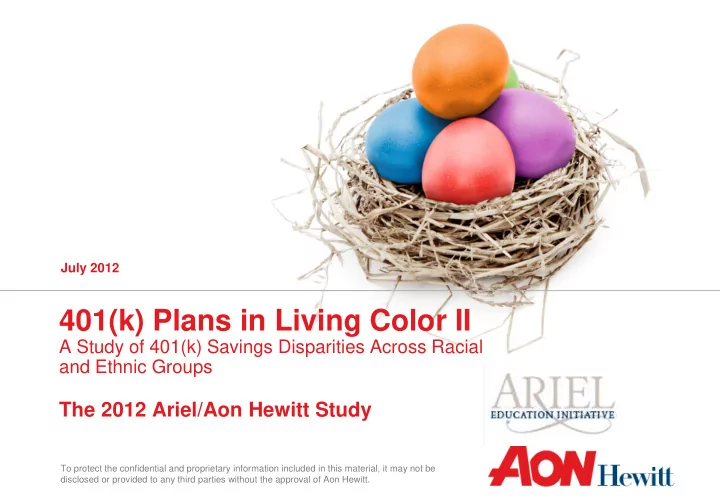

July 2012 401(k) Plans in Living Color II A Study of 401(k) Savings Disparities Across Racial and Ethnic Groups The 2012 Ariel/Aon Hewitt Study To protect the confidential and proprietary information included in this material, it may not be disclosed or provided to any third parties without the approval of Aon Hewitt.
401(k) Plans in Living Color: The Ariel/Hewitt Study Study sponsored by the Ariel Education Initiative and Aon Hewitt and includes several partner organizations Groundbreaking research that uncovers the relationship between race/ethnicity and 401(k) behaviors Expanded data set and analysis covering: – Nearly 2.5 million employees – 60 participating employers – Data as of December 31, 2010 Includes employee survey perspective, with over 19,000 online responses (deployed by three large employers to 150,000 employees). Deployed in 3Q-4Q 2011. Focused on: – What is happening outside the plan – Plan knowledge – Perceptions on current and potential initiatives 2 2
Study Results: The Big Headlines African-American and Hispanic retirement savings continues to significantly lag Whites Economic downturn exacerbated the differential, and disproportionately impacted minorities Even when we adjust for age, pay, and other factors, we find: – Significantly lower participation and savings rates – Dramatically higher use of loans and hardship withdrawals for both, but especially for African-Americans Overall, Asian employees again showed strongest plan behaviors 3 3
Study Results: Overall Plan Usage by Race/Ethnicity Largest behavior changes from previous study seen among: Participation rates flat, given impact of auto enrollment Savings rates are down across all Loan usage is up for all, markedly for African-Americans and Hispanics (up 10 %) Hardship withdrawals are up across all, markedly for African Americans (up from 6.3%) African- White American Hispanic Asian Total Participation 1 79% 68% 66% 80% 72% Average Contribution Rate 2 7.2% 5.6% 5.9% 8.8% 6.9% Percentage With Loans 3 26% 49% 40% 22% 29% Percentage Taking a Withdrawal 4 1.7% 8.8% 3.2% 1.2% 3.0% 1 Measure of active and eligible employees who made any contribution (before-tax, after-tax, or Roth) in 2010. 2 Average of before-tax, after-tax, and Roth contribution rate as of 12/31/2010 among participants. Excludes nonparticipants. 3 Percentage of active employees with a balance who had a loan outstanding on 12/31/2010. 4 Percentage of active employees with a balance who took a hardship withdrawal during 2010. 4 4
Balances Considerable differences remain in account balance across all pay ranges. Influenced by other variables (age, job tenure, pay within range, etc.) Yet, differences still exist when you adjust for those factors Account Balance by Race/Ethnicity and Pay $30,000– $60,000– $90,000– < $30,000 $59,999 $89,999 $119,999 $120,000+ White $14,458 $42,931 $101,359 $185,036 $285,729 African- $7,579 $25,122 $71,784 $138,944 $204,513 American Hispanic $9,010 $28,294 $79,933 $140,677 $211,422 Asian $16,193 $41,792 $87,581 $135,516 $182,562 5 5
Five Key Recommendations in the Study Call to action for employers, regulators, service providers and individuals… Five Key Recommendations: 1. Know your employees: Understand your demographics and assess participant behaviors by multiple perspectives–including race 2. Use automation to its full potential: Utilizing more compelling defaults to spur better behavior 3. Ease loan repayment and deter early withdrawals 4. Add an array of investment advisory services and support 5. Don’t forget about communication opportunities 6 6
Considerations for Participation Benefits Barriers Better understanding of behaviors Perceived risk of having this data Improved ability to make positive change – Litigation risk Recognition as an employer committed to – PR risk the financial security of employees Time and effort required to gather data Recognition as an employer committed to – Not a part of standard recordkeeping diversity & inclusion reporting or data structures – Competing resources in lean times Difficulty of obtaining internal approval – Decision rights across payroll/ IT, benefits/ HR, legal, diversity & inclusion 7 7
Appendix – Study Partners Ariel Education Initiative and Ariel Investments, LLC: Ariel Education Initiative, the nonprofit affiliate of Ariel Investments, was founded in 1989 by John W. Rogers, Jr. (founder and chairman of Ariel Investments, LLC) as a private operating foundation with a mission to strengthen the neighborhoods and cities in which we live and work. Ariel Investments is a Chicago-based money management firm and mutual fund company that serves individual investors through its no-load mutual funds and manages separate accounts for institutional clients. Aon Hewitt: Aon Hewitt is the global leader in human resource consulting and outsourcing solutions. The company partners with organizations to solve their most complex benefits, talent and related financial challenges, and improve business performance. Aon Hewitt designs, implements, communicates and administers a wide range of human capital, retirement, investment management, health care, compensation and talent management strategies. With more than 29,000 professionals in 90 countries, Aon Hewitt makes the world a better place to work for clients and their employees. For more information on Aon Hewitt, please visit www.aonhewitt.com. The Joint Center on Political and Economic Studies is the nation’s leading African-American think tank and is focused on political, economic, and health issues. The Raben Group is a D.C.-based public affairs organization. The Raben Group assists non-profit, foundation, and corporate clients with a variety of services ranging from strategic planning to policy development to strategic communications. 8 8
Recommend
More recommend